Atomic habits cheat sheet and worksheets to help you build good habits and break bad ones.
James Clear, the author of the Atomic Habits book, focuses on habits and how they can help people improve their lives. The following Atomic Habits summary includes printable cheat sheets and worksheets. We also offer a free workbook with 23 pages of Atomic Habits worksheets. There is also a free online quiz to help you use the habit-stacking system to build new habits and a habit contract generator to create your own custom habit contract.
Please note: This is an unofficial summary and workbook created to help you understand and apply the principles outlined in the book. For full disclaimer details, click here.
Atomic Habits Cheat Sheet
Atomic Habits Cheat Sheets to Change Specific Habits
We offer many cheat sheets that show you how to apply the Atomic Habits principles to develop or change specific habits.
Quit Smoking | Exercise Regularly | Reduce Alcohol Intake | Improve Sleep | Reduce Stress | Improve Eating Habits | Drink More Water | Stop Procrastination and Be More Productive |
How to Build New Habits
How to Break Bad Habits
How to Stick to Our Habits
Atomic Habits Worksheets
The Atomic Habits worksheets PDF format is editable so you can type on them before you print. The worksheet templates are also available as images if you want to write on them and not type.
Atomic Habits Worksheets PDF – 23 Pages
This free printable journal has 23 pages of Atomic Habits worksheets in PDF format. The workbook is typeable so you can use it on your PC, iPad, or tablet without printing it. If you prefer to download only specific resources such as a scorecard, cheat sheet, or habit contract then see below.
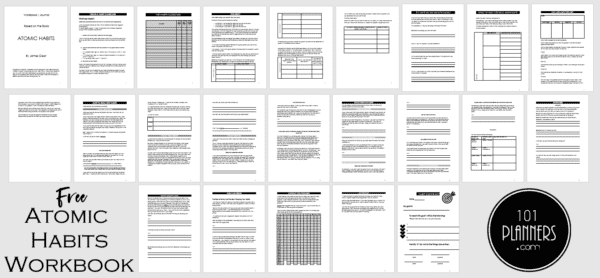
Workbooks that Apply the Atomic Habits Principles to Build or Break Specific Habits
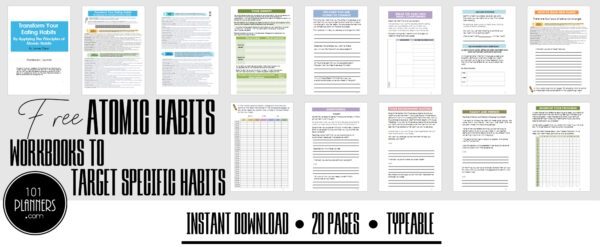
The following workbooks show you how to apply Atomic Habits to specific habits:
Quit Smoking
Exercise Regularly
Reduce Alcohol Intake
Improve Eating Habits
Atomic Habits Scorecard
- Make a list of your daily habits
List all things you do on a daily basis and without thinking such as waking up, brushing your teeth, checking your phone, taking a shower, drinking coffee, etc.
- Look at each behavior and ask yourself if it is a good, bad or neutral habit.
- If it is a good habit (i.e. it will benefit you in the long run), write “+” next to it.
- If it is a bad habit (i.e. it will have a negative outcome in the long run), write “–” next to it.
- If it is a neutral habit, write “=” next to it.
- Be aware of your habits
There is no need to change anything at first. The goal is to simply notice what is actually going on. Observe your thoughts and actions without judgment or internal criticism.
The idea is to get you to recognize your habits and acknowledge the cues that trigger them. This will make it easier to discover which habits you should change and respond in a way that benefits you.
Habit Contract
Use our free habit contract generator to create your own custom habit contract.
We also offer free habit contracts to target specific habits such as a:
- Habit Contract to Quit Smoking
- Habit Contract to Develop Better Eating Habits
- Habit Contract to Exercise Regularly
Atomic Habits Summary
This is a summary of the Atomic Habits book which is based on the idea that small changes can cause remarkable results. We also offer a free Atomic Habits workbook PDF below with additional resources that will help you develop or change your habits.
What are habits?
How are habits formed?
The process of building a habit can be divided into four simple steps: cue, craving, response, and reward. Clear suggests that by manipulating these components—making cues obvious, cravings attractive, responses easy, and rewards satisfying—one can effectively establish positive habits and alter unfavorable ones.
- Cue – Habits begin with a cue, or a trigger to act. This is the trigger that initiates the habit loop. It is an external or internal stimulus that signals the brain to start the behavior. It can be something in your environment, a specific time of day, an emotional state, or the company of specific people. For example, walking into a dark room, cues you to perform an action that will enable you to be able to see.
- Craving – After recognizing the cue, the brain begins to anticipate the reward, creating a craving or desire to perform the habit. It is the motivational force behind every habit. Without it, the behavior will not occur. For example, after walking into a dark room, there is a craving for a change in state. In our example, to be able to see.
- Response – Then comes our response, or action. This is the actual habit or behavior that you perform, driven by the craving. Whether a response occurs depends on how motivated you are and how much friction is associated with the behavior. In our example, flicking the light switch.
- Reward – The final step in the process, and the end goal of every habit, is the reward. The reward delivers satisfaction and pleasure, fulfilling the craving, and it serves to reinforce the habit loop, making it more likely that you will repeat the behavior in the future when exposed to the cue. This tells your brain, that the next time this cue happens do the same thing to get the same reward. In this example, being able to see your surroundings.
If you follow this cycle often enough it starts happening without thinking about it. That is the basis of habit formation.
Every habit is subject to the same process.
Unfortunately, not all habits are good for us, but the process is the same for both good and bad habits.
Small habits can have a huge impact on your life
We don’t notice tiny changes, because their immediate impact is negligible. However, these small changes, if repeated every day, can cause major changes in our lives. You might not even notice that change is taking place but over time you will see a difference. Tiny atomic habits are anchored on small changes that lead to great results over time (that is how the book got its name “Atomic Habits”).
“Small changes often appear to make no difference until you cross a critical threshold. The most powerful outcomes of any compounding process are delayed. You need to be patient.”
“If you want to predict where you’ll end up in life, all you have to do is follow the curve of tiny gains or tiny losses, and see how your daily choices will compound ten or twenty years down the line.” I thought that that was a particularly powerful quote.
Focus more on building a system than setting goals
If you want better results, then forget about setting goals. Focus on your system instead. As James Clear explains, “Goals are about the results you want to achieve. Systems are about the processes that lead to those results.”True long-term thinking focuses more on building effective systems than setting goals. The idea is not to achieve a single accomplishment but to create a cycle of endless refinement and continuous improvement.
Your habits shape your identity and vice versa
There are three layers of behavior change:
- a change in your outcomes (i.e. what you get or what you achieve)
- a change in your processes (i.e. what you do)
- or a change in your identity (i.e. what you believe)
- “It is a simple two-step process: Decide the type of person you want to be. Prove it to yourself with small wins.”
- “Ask yourself, “Who is the type of person that could get the outcome I want?” Then be that person.
- “The real reason habits matter is not because they can get you better results (although they can do that), but because they can change your beliefs about yourself.”
How to Build New Habits
There is a printable cheat sheet for this section below.
The Four Laws of Behavior Change
| Rule | To Form a Good Habit | To Break a Bad Habit | Relevant Step |
| 1st | Make it obvious | Make it invisible | Cue |
| 2nd | Make it attractive | Make it unattractive | Cravings |
| 3rd | Make it easy | Make it difficult | Response |
| 4th | Make it satisfying | Make it unsatisfying | Reward |
There are four laws of behavior change:
1. 1st Law – Make it Obvious
We all have cues that trigger certain habits. Since certain stimuli can prompt habitual behavior, you can use this to change your habits.
For example,
- If you want to exercise more often then leave your running shoes and gym clothes somewhere where you won’t miss them.
- If you want to eat healthier food, then put your cut vegetables on the shelf that you see as you open your fridge instead of hiding them in the vegetable drawer.
Don’t spend time in tempting situations. It’s easier to avoid temptation than to resist it.
Use Habit Stacking
After [EXISTING HABIT], I will [NEW HABIT].
Identify a habit you already do every day and then stack your new behavior on top. This is called habit stacking. For example, I will do yoga right after I brush my teeth every morning.
Use implementation intentions (a clear plan of action, setting out when and where you’ll carry out the habit you’d like to cultivate).
I am going to [ACTION] for [X MINUTES] at [TIME] at/in [PLACE]
If you want to build new habits you must have a clear plan of action. Don’t say, “I’m going to start working out,” and simply hope that you’ll follow through. Instead, say “I’ll work out on Sunday, Tuesday, and Thursday at 7 AM for 20 minutes”.
An implementation intention introduces a clear plan of action, setting out when and where you’ll carry out the habit you’d like to cultivate. Research shows that this is the most effective way to cultivate a new habit.
Use this habit-stacking template to help you build new habits on old habits.
2. 2nd Law – Make it Attractive
Humans are motivated by the anticipation of reward, so making habits attractive will help you stick to them. Our brain releases dopamine (a hormone that makes us feel good) when we do activities that we enjoy. However, dopamine is also released when we anticipate these activities not only when we actually do them. That is why planning a vacation is so enjoyable and part of the fun. We can use this to our advantage when trying to form new habits. If we make a habit something we look forward to, we’ll be much more likely to follow through and actually do it. James Clear suggests using “temptation bundling” to do this. Temptation bundling is when you take a behavior that you want to adopt that is unappealing and link it to a behavior that you enjoy (one that will cause your brain to release dopamine). For example, make a decision that you will only watch TV in general or a specific program that you enjoy when you are on the treadmill.
Temptation bundling
How to Create Your Temptation Bundle
Image (Page 1 / Page 2) | Typeable PDF
You can combine temptation bundling with the habit-stacking strategy above.
For example, if you want to watch TV or drink coffee, but you need to exercise:
1. After I get my morning coffee, I will exercise (need).
2. After I exercise, I will watch TV (want).
3. 3rd Law – Make it Easy
If you want to build a new habit, make that habit as easy to adopt as possible.
We will naturally gravitate toward the option that requires the least amount of work. Therefore, making behaviors as easy as possible is important to turn them into habits. Create an environment where doing the right thing is as easy as possible. James Clear gives a few tips to make habits seem easier in the long term.
Focus on reducing friction
If you want to do something, then make sure that the supplies are available so that there’s no friction. For example, if you want to go for a run, then keep your running gear out. If you don’t want to waste time on your phone, then don’t keep it nearby while you are working or simply turn it off. Doing so will introduce enough friction to ensure you only use it when you need to.
The two-minute rule
“The Two-Minute Rule states, ‘When you start a new habit, it should take less than two minutes to do.’”
This is another way to make any new activity feel manageable. The rule recognizes that simply getting started is the first and most important step toward doing something. If you want to start running, then commit to running for two minutes only. Once you start running, you will probably keep going.
Make your habits immediately satisfying to help you change your behavior.
- For example, when we work out every day we will eventually get fitter but we don’t see the change every day. On the other hand, bad habits often do have immediate satisfaction such as the enjoyment from eating chocolate.
- For example, if you want to start losing weight, start saving for something that you really want to buy. Each day that you eat well and/or work out put a dollar (or however much you decide on) into the savings account to save for something you really want. You will now get some short-term satisfaction each time you put money into your account. This will keep you on track until you reach your long-term goals.
The Role of Family and Friends in Shaping Your Habits
How can we stick to our habits?
Habit Trackers
A habit tracker is a simple way to measure whether you did a habit. It is basically like marking an X on a calendar.
A habit tracker is an effective technique to keep your habits on track since one of the most satisfying feelings is the feeling of making progress. “Habit trackers and other visual forms of measurement can make your habits satisfying by providing clear evidence of your progress.”
Habit Contract
A habit contract is a written agreement between yourself and someone else (or a group of people) that outlines the specific habits you want to form and the consequences and rewards associated with sticking to or deviating from those habits.
The purpose of a habit contract is to increase accountability and motivation toward forming and sticking to habits. By having a written agreement, you have made a commitment to someone else (or a group of people), which can increase your sense of obligation to follow through with your goals. The consequences and rewards outlined in the contract can also increase motivation and reinforce positive behavior.
For example, a habit contract may state that if you successfully exercise every day for a week, you will treat yourself to a massage, but if you miss a day, you will donate $50 to a charity of your choice.
It’s important to choose consequences and rewards that are meaningful to you and will help increase your motivation to stick to your habits. Habit contracts can be used for a variety of habits, from exercise and healthy eating, to studying and working on a specific project.
A habit contract is a good framework to keep your habits on track since it imposes negative consequences if you fail to do so.
How to Break Bad Habits
1. Make your cues invisible
We all have cues that trigger certain habits. The buzz of your phone, for example, is a cue to check your messages. If you find yourself wasting a lot of time on social media or on your phone, then move your phone away while you are working or put it on silent.
2. Make your bad habits unappealing
“Habits are attractive when we associate them with positive feelings and unattractive when we associate them with negative feelings. Create a motivation ritual by doing something you enjoy immediately before a difficult habit.”
3. Make the bad habit as difficult as possible
Focus on increasing friction
For example, if you don’t want to waste time on your phone, then don’t keep it nearby while you are working or simply turn it off. Doing so will introduce enough friction to ensure you only use it when you need to.
Use the two-minute rule
For example, if you are trying to diet and have a craving for chocolate, do something you enjoy for two minutes. The chances are your craving will be over after two minutes if you don’t act on it immediately.
Use a commitment device
For example, if you want to save money, then you enroll in an automatic savings plan.
“Using technology to automate your habits is the most reliable and effective way to guarantee the right behavior.
4. Make your habit unsatisfying
The most important rule for behavioral change is to make bad habits unsatisfying. This can be difficult since bad habits often have immediate satisfaction such as the enjoyment from eating chocolate even if they are unsatisfying in the long run.
Attach some immediate satisfaction to avoiding a bad habit
For example, each day that you don’t do your bad habit put a dollar (or however much you decide on) into a savings account. You will now get some short-term satisfaction each time you put money into your account. This will keep you on track until you reach your long-term goals.
Use a habit contract
A habit contract is a good framework to keep your habits on track since it imposes negative consequences if you fail to do so.
Atomic Habits Quotes
The following Atomic Habits Quotes are powerful sentences from the Atomic Habits book.
“A habit is a behavior that has been repeated enough times to become automatic.”
“Small changes often appear to make no difference until you cross a critical threshold. The most powerful outcomes of any compounding process are delayed. You need to be patient.”
“If you want to predict where you’ll end up in life, all you have to do is follow the curve of tiny gains or tiny losses, and see how your daily choices will compound ten or twenty years down the line.”
“It is a simple two-step process: Decide the type of person you want to be. Prove it to yourself with small wins.”
“Ask yourself, “Who is the type of person that could get the outcome I want? Then be that person.”
“The real reason habits matter is not because they can get you better results (although they can do that), but because they can change your beliefs about yourself.”
“Habits are attractive when we associate them with positive feelings and unattractive when we associate them with negative feelings. Create a motivation ritual by doing something you enjoy immediately before a difficult habit.”
“Using technology to automate your habits is the most reliable and effective way to guarantee the right behavior.”
Atomic Habits Review
Atomic Habits by James Clear: A Transformative Guide to Habit Formation
“Atomic Habits,” written by James Clear, is a groundbreaking exploration into the science of habits, and it has earned its accolades as a definitive guide in its field. Clear masterfully dismantles the complexities of habit formation and alteration, presenting them in an accessible, user-friendly format.
The core premise of the book rests on the notion that tiny changes can yield remarkable results, providing a fresh perspective on the power of incremental progress. Clear introduces the Four Laws of Behavior Change, which are integral in creating beneficial habits and dismantling the detrimental ones: Make it Obvious, Make it Attractive, Make it Easy, and Make it Satisfying.
I found the book to be extremely effective. I have read many books on habit formation and yet this one still stood out. I love the idea of starting with small changes. I have tried to change my habits many times over the years and have never really been successful in the long term. I love the two-minute rule. I don’t have a lot of spare time but I can spare two minutes. When I start out planning to exercise for two minutes I often carry on, but if I didn’t initially plan to go for two minutes, then I wouldn’t have started. I am an “all-or-nothing” kind of person so the two-minute rule was a game-changer for me. The main idea of the Atomic Habits book is that tiny changes add up over time and make a big difference. Before I read the book I didn’t really bother making small changes. I would set my goals to exercise for an hour or two a day and then eventually land up doing nothing.
The concept of “habit stacking,” where new habits are seamlessly integrated with existing ones, is particularly insightful, offering a practical approach to incorporate new behaviors into one’s routine. Moreover, Clear provides actionable strategies and tools, like the Habit Scorecard and Habit Contract, empowering readers to meticulously analyze and modify their behaviors.
In “Atomic Habits,” James Clear eloquently illustrates the profound impact of identity transformation, asserting that true and lasting change is not just about the outcomes or processes but is fundamentally anchored in altering one’s self-perception and beliefs, in essence reshaping who you believe you are, which in turn propels sustained habit alteration and personal development. I personally found this concept to be really powerful.
Clear’s writing is engaging and insightful, interspersing scientific studies with real-life anecdotes, making the read both enlightening and relatable. The book’s structure is well-organized, allowing readers to easily follow along and implement the strategies provided.
While the book is steeped in practical advice, its real triumph is in its ability to inspire change and offer a sustainable path forward for those looking to enhance their lives through habit modification. Whether you are aiming to break free from the chains of destructive habits or yearning to build a life enriched with positive behaviors, “Atomic Habits” provides the blueprint.
I am a very goal-oriented person and this book puts more focus on the process than the goal, which I found to be an interesting concept and I started putting more focus on processes in my life as a result.
Final Thoughts:
“Atomic Habits” is more than just a guide; it’s a catalyst for transformative change, making it a must-read for anyone eager to master the art of habit formation. Its pragmatic, well-researched approach makes it a timeless resource in personal development.
The book is easy to read so it was enjoyable as well. Some books are too academic or detailed and I feel like I’m back at school. This book was an easy read and very practical which I love. It is full of actionable advice. I also liked the fact that there are many strategies presented in the book. You are bound to find at least a few helpful.
Rating: ★★★★★
James Clear’s “Atomic Habits” is a revelation in understanding and transforming habits, a book that has the potential to alter the trajectories of lives by harnessing the power of small changes.

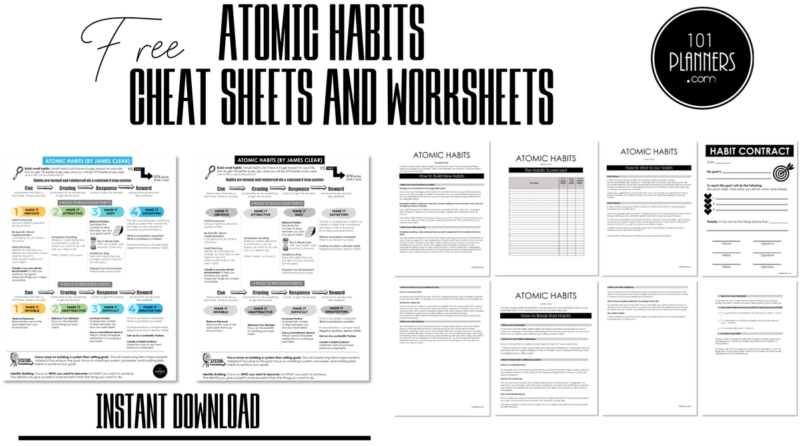
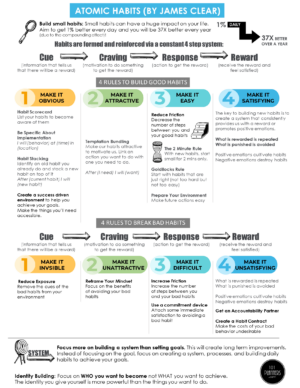
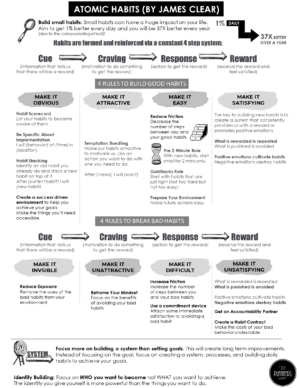
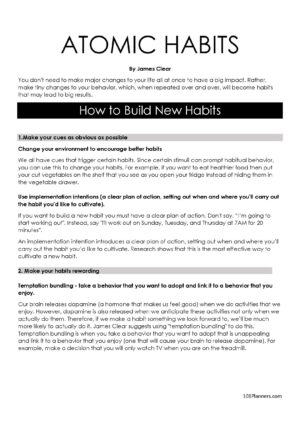
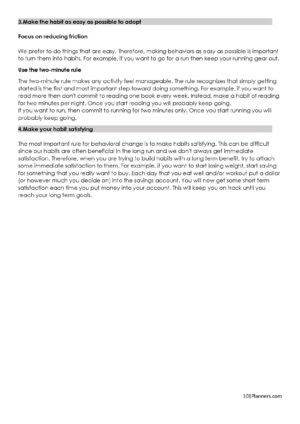
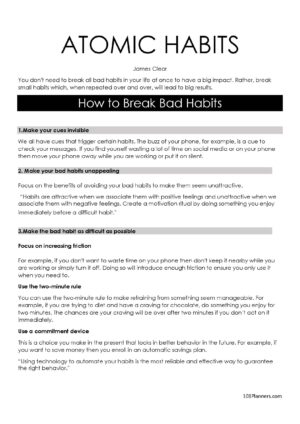
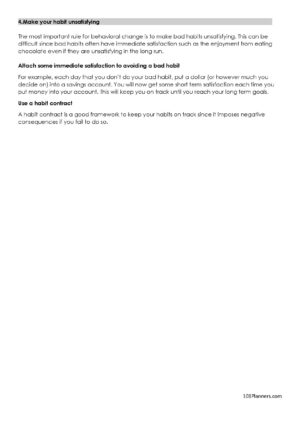
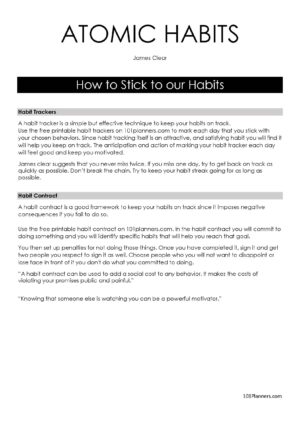
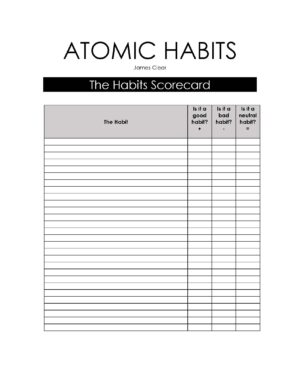
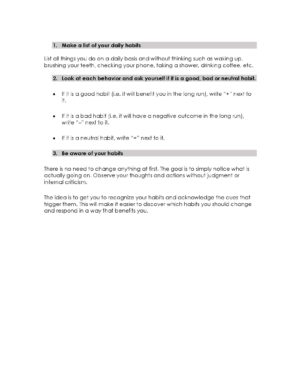
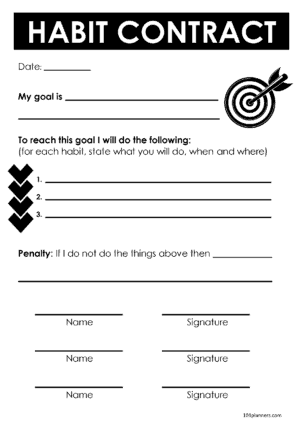
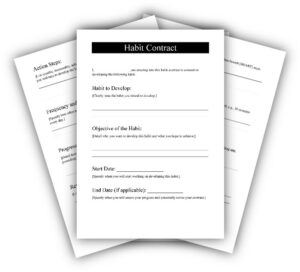
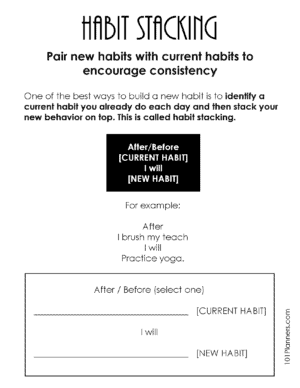
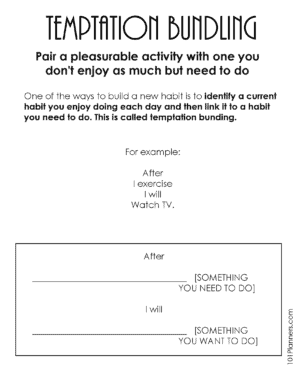
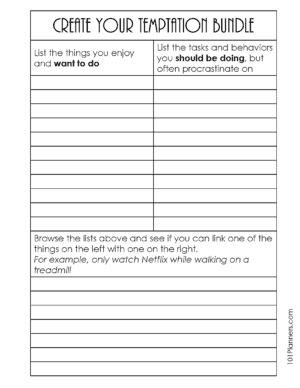
 My name is
My name is
I found the information very useful and helpful. I would recommend this to anyone.
I found this book and worksheets very helpful, even though I am retired.
Wish I had this earlier. Recommend this book for anyone who desires to
improve organization and develop high yielding habits.
Not able to download any of the pdfs. Very nice summary. Thank you
Carl, once you select the PDF and click on it it will open. In the top right corner, there is a download or print button. To download the PDF just click on the download icon and it will download instantly.
Thanks for all these great worksheets! I also really enjoyed the book and used it to put positive habits in place, but lately I see I need to go back for a refresher – so thanks for this 🙂
This was so helpful. Thank you so much. Do you provide coaching service on habits?
We don’t provide a coaching service but we will have a free online course soon.
finally, I found this great information in a essay way to understand and apply in every area . thanks Niccole. Blessings.
Excelente publicación. El libro de trabajo y demás formularios no están disponibles en español? Gracias.
Thank you for all this helpful stuff! Excellent!
Thank you so much for this! I purchased Atomic Habits as an audio book and by the time I went to get the media files from the website they are no longer available. This will be so helpful!
Really effective and worth Reading…Loved it..
Loved it
Thank you for this free resource!
I found I was already utilizing some of these strategies, I love printing out these worksheets to monitor my habits!